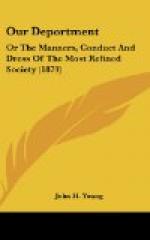WEDDINGS AT HOME.
Weddings at home vary but little from those at church. The music, the assembling of friends, the entree of the bridal party to the position selected, are the same. An altar of flowers, and a place of kneeling can be easily arranged at home. The space behind the altar need be no wider than is allowed for the clergyman to stand. The altar is generally only a fender or railing entirely wound and concealed by greenery or blossoms. Other floral accessories, such as the marriage-bell, horseshoe, or white dove, etc., can be arranged with ease by a skillful florist, if desired.
When the marriage ceremony is concluded, the party turn in their places and face their friends, who proceed to congratulate them. If space be required, the kneeling stool and floral altar may be removed, a little later, without observation.
THE EVENING WEDDING.
If the wedding occur in the evening, the only difference in the ceremonials from those in the morning is that the ushers or groomsmen wear full evening dress, and the bridal pair retire quietly to dress for their journey before the dancing party disperses, and thus leave unobserved. At the morning wedding only bridemaids, ushers and relatives remain to witness the departure of the pair.
“AT HOME” RECEPTIONS.
When the newly married couple commence life in a home of their own, it is customary to issue “at home” cards for a few evenings, at an early date after the wedding, for informal receptions. Only such persons are invited as the young couple choose to keep as friends, or perhaps only those whom they can afford to retain. This is a suitable opportunity to carefully re-arrange one’s social list, and their list of old acquaintances may be sifted at the time of the beginning of housekeeping. This custom of arranging a fresh list is admitted as a social necessity, and nobody is offended.
CALLS.
All guests and friends who receive “at home” invitations, or who are invited to the church, are required by etiquette to call upon the family of the bride, or to leave their cards, within ten days after the wedding.
THE WEDDING RING.
All churches at present use the ring, and vary the sentiment of its adoption to suit the customs and ideas of their own rites. A jeweled ring has been for many years the sign and symbol of betrothal, but at present a plain gold circlet, with the date of the engagement inscribed within, is generally preferred. The ring is removed by the groom at the altar, passed to the clergyman and used in the ceremony. A jeweled ring is placed upon her hand by the groom on the way home from the church, or as soon after the service as is convenient. It stands guard over its precious fellow, and is a confirmation of the first promise.




